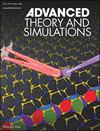Nano- to Mm-Scale Fluid Dynamic Phenomena Induced by Plasmon-Assisted Photothermal Effect in Microfluidic Channels
IF 2.9
4区 工程技术
Q1 MULTIDISCIPLINARY SCIENCES
引用次数: 0
Abstract
Photothermal effect induced by plasmonic nanostructures has been widely used for fluid manipulation and heat transport in lab-on-a-chip applications based on microfluidics. In this article, a comprehensive multiscale and multiparameter study is presented for a 3D gold nanoparticles (AuNPs) based optofluidic channel. Multiphysics simulations using finite element method (FEM), consisting of electromagnetic, thermal, and fluid flow fields are used to analyze both steady-state spatial distribution and transient evolutions of the thermally driven fluid dynamic phenomena in the microscopic field. This study demonstrates that a nano-scale thermal gradient can lead to nm-scale changes in fluid dynamics and on the nano-scale, while such convection does not significantly affect the steady-state temperature distribution, even in the presence of injection flow, but the localized thermal-driven convection will contribute to the flow dynamics to some extent. Given the millimetric size of the heat source in microfluidic system, convection exerts a powerful influence to control fluid motion and temperature gradient. Moreover, thanks to a comprehensive parameter study involving AuNPs temperature, channel height, and injection flow velocity, this work elucidates the role of pressure-driven flow and thermal-induced convection in controlling fluid and mass transport in microfluidic conditions, which will enhance the functionality of plasmofluidics for various bioapplications.

微流体通道中等离子体辅助光热效应诱导的纳米至毫米尺度流体动力学现象
等离子体纳米结构引起的光热效应已广泛应用于基于微流控的芯片实验室流体控制和热输运。本文对三维金纳米颗粒(AuNPs)光流通道进行了多尺度、多参数的综合研究。采用有限元法进行多物理场模拟,包括电磁场、热场和流体流场,分析了热驱动流体动力学现象在微观场中的稳态空间分布和瞬态演化。本研究表明,纳米尺度的热梯度会导致流体动力学和纳米尺度的纳米级变化,而这种对流即使在有注入流动的情况下也不会显著影响稳态温度分布,但局部热驱动对流会在一定程度上促进流动动力学。考虑到微流体系统热源的毫米级尺寸,对流对流体运动和温度梯度的控制具有强大的影响。此外,通过对AuNPs温度、通道高度和注射流速的综合参数研究,本工作阐明了压力驱动流动和热诱导对流在控制微流体条件下流体和质量输运中的作用,这将增强等离子体流体在各种生物应用中的功能。
本文章由计算机程序翻译,如有差异,请以英文原文为准。
求助全文
约1分钟内获得全文
求助全文
来源期刊

Advanced Theory and Simulations
Multidisciplinary-Multidisciplinary
CiteScore
5.50
自引率
3.00%
发文量
221
期刊介绍:
Advanced Theory and Simulations is an interdisciplinary, international, English-language journal that publishes high-quality scientific results focusing on the development and application of theoretical methods, modeling and simulation approaches in all natural science and medicine areas, including:
materials, chemistry, condensed matter physics
engineering, energy
life science, biology, medicine
atmospheric/environmental science, climate science
planetary science, astronomy, cosmology
method development, numerical methods, statistics
 求助内容:
求助内容: 应助结果提醒方式:
应助结果提醒方式:


